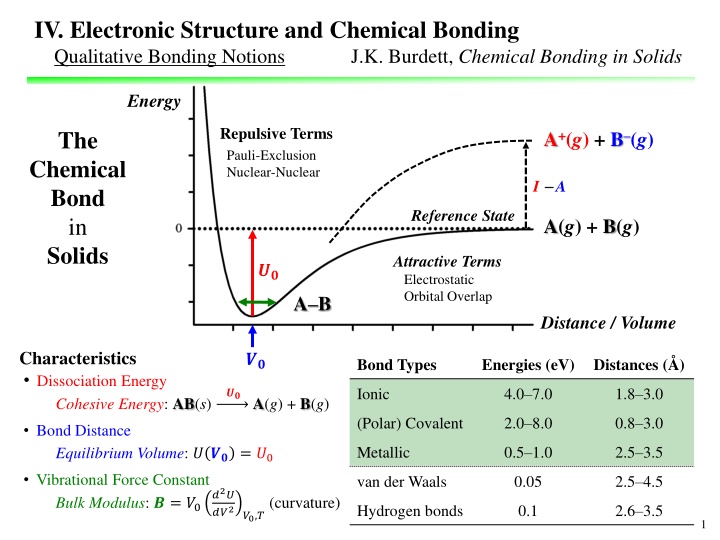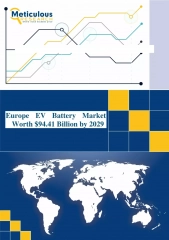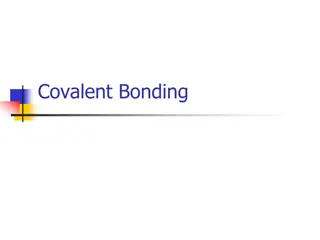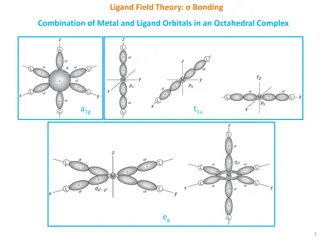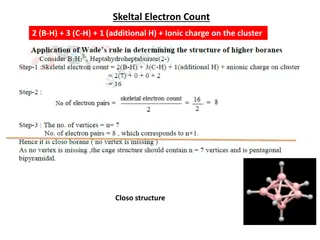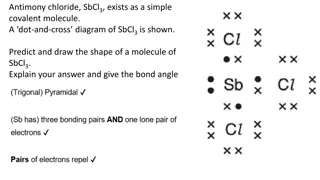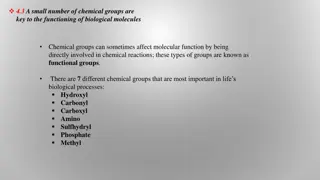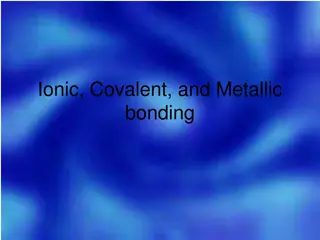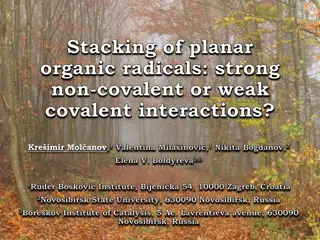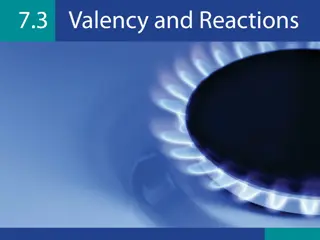Comprehensive Overview of Electronic Structure and Chemical Bonding
Electronic structure considerations, chemical bonding theories, experimental measurements, and theoretical analyses in solids. Topics include qualitative bonding notions, energy terms, bond types, vibrational properties, and electron density analyses. Illustrations and in-depth discussions provided.
Download Presentation

Please find below an Image/Link to download the presentation.
The content on the website is provided AS IS for your information and personal use only. It may not be sold, licensed, or shared on other websites without obtaining consent from the author.If you encounter any issues during the download, it is possible that the publisher has removed the file from their server.
You are allowed to download the files provided on this website for personal or commercial use, subject to the condition that they are used lawfully. All files are the property of their respective owners.
The content on the website is provided AS IS for your information and personal use only. It may not be sold, licensed, or shared on other websites without obtaining consent from the author.
E N D
Presentation Transcript
IV. Electronic Structure and Chemical Bonding Qualitative Bonding Notions J.K. Burdett, Chemical Bonding in Solids Energy Repulsive Terms Pauli-Exclusion Nuclear-Nuclear The The A+(g) + B (g) Chemical Bond Chemical Bond in Solids I A Reference State A(g) + B(g) Attractive Terms Electrostatic Orbital Overlap ?? A B Distance / Volume Distance Characteristics Characteristics Dissociation Energy ?? Bond Types Energies (eV) Distances ( ) Cohesive Energy: AB(s) ?? Ionic 4.0 7.0 1.8 3.0 A(g) + B(g) (Polar) Covalent 2.0 8.0 0.8 3.0 Bond Distance Metallic 0.5 1.0 2.5 3.5 Equilibrium Volume: ? ?? = ?0 Vibrational Force Constant van der Waals 0.05 2.5 4.5 ?2? ??2 Bulk Modulus: ? = ?0 ?0,? (curvature) Hydrogen bonds 0.1 2.6 3.5 1
IV. Electronic Structure and Chemical Bonding Qualitative Bonding Notions J.K. Burdett, Chemical Bonding in Solids Experimental Measurement and Assessments Electrical Conductivity (thermal or optical) band gaps Magnetic Susceptibility localized or itinerant; para- or diamagnetic Heat Capacity specific heat due to conduction electrons and lattice Cohesive Energy energy required to convert M(s) to M(g) Spectroscopy valence electronic density of states; core state binding energies Phase Changes structure changes with temperature or pressure variations Theoretical Analysis and Interpretations Electronic Density of States (DOS curves) occupied and unoccupied states Electron Density where does electronic charge build up in a solid? Analysis of DOS bonding vs. antibonding overlap (Hamilton) populations Band structure energy dispersion relations Equations of State ? ? curves to interpret phase changes Phonon DOS vibrational states of crystals; stability of structures (? < ? ??) Molecular Dynamics phase transitions; crystallization models 2
IV. Electronic Structure and Chemical Bonding Qualitative Bonding Notions: van Arkel-Ketelaar Triangle (Basics) CsF Large ? e transfer from METALS to NONMETALS e slocalized on ANIONS Ionic Dense Packed Electronegativity Difference ? InBr Decreasing Decreasing Structural Anisotropy Electron Delocalization LiAl Small ? Small ? High valence e /orbital ratio Large ? ; High IP(I) e slocalized in BONDS Low valence e /orbital ratio Small ? ; Low IP(I) e sdelocalized GaAs Metallic Dense Packed Covalent Molecular Decreasing Electron Transfer Cs F Na Mg Al Si P S Cl ? Pauling: The power of an atom in a compound to attract e s to itself. Average Electronegativity L.C. Allen, JACS, 1989, 111, 9003; 1992, 114, 1510 L.C. Allen et al., JACS, 2000, 122, 2780 and 5132 Mulliken: ? ? + ? 3
IV. Electronic Structure and Chemical Bonding Qualitative Bonding Notions: van Arkel-Ketelaar Triangle (Physical Properties) CsF Electrical insulators; Conducting liquids Diamagnetic or localized magnetism Brittle Transparent Ionic Dense Packed Electronegativity Difference ? InBr Electrical Conductors Paramagnetic or itinerant magnetism Soft malleable, ductile Reflective Electrical Insulators Diamagnetic or localized magnetism Volatile (low boiling points) Transparent LiAl GaAs Metallic Dense Packed Covalent Molecular Cs F Na Mg Al Si P S Cl ? Average Electronegativity 4
IV. Electronic Structure and Chemical Bonding Qualitative Bonding Notions: van Arkel-Ketelaar Triangle How can we understand the different types of chemical bonding in solids? CsF ?? M(g) + X(g) MX(s) Ionic Dense Packed Electronegativity Difference ? InBr Polar-Covalent Extended; Oligomeric Elect. Semiconductors or Semimetals Diamagnetic Hard Brittle Opaque Electrical Semiconductors Diamagnetic Hard Brittle Transparent Zintl Phases Polyanionic Nets LiAl Transparent GaAs Metallic Dense Packed Covalent Molecular ?? ?? M(g) M(s) X(g) X(s) Metalloids Extended; Oligomeric Cs F Na Mg Al Si P S Cl Elect. Semiconductors or Semimetals Diamagnetic ? Average Electronegativity Hard Brittle Opaque Nonreflective 5
IV. Electronic Structure and Chemical Bonding Qualitative Bonding Notions: Ionic Solids Madelung Potential ??=14.4 ?? ? ?( ) NaCl eV Eg (eV) Li F Cl Br Conduction Band 13.6 9.4 7.6 Energy INa ACl = 1.52 eV Na+ 3s Na 11.6 8.5 7.5 K 10.7 8.4 7.4 Na 3s Rb 10.3 8.2 7.4 Cs 9.9 8.3 7.3 Cl 4s Cl 3p P.K. de Boer, etc., Phys. Lett. A, 1999, 256, 227 Eg > 3 eV Na+ 3s MAX 400 nm Valence Band Cl 3p Polarization NaCl(s) Cl 3p Na+(g) + Cl (g) Na(g) + Cl(g) 6
IV. Electronic Structure and Chemical Bonding Qualitative Bonding Notions: Covalent Solids Si (Diamond) Semiconducting Orthogonal in space not in energy Energy Conduction Band sp3 Hybrids Ep 1 2.2 Hvap 7.4 2 7.1 (eV) Eg 5.5 C Si 1.1 1.8 4.1 4.7 Eg < 3 eV Ge 0.6 2.1 4.5 3.5 MAX > 400 nm Sn 0.1 Eg 2 2 4 1 1.9 3.9 3.0 Es Hvap = 4.72 eV Si(s) Si(g) t2 a1 Hvap 4D(Si-Si) / 2 = 4.72 eV D(Si-Si) / 2 = 2.36 eV 2.34 eV 12-14 eV 18-19 eV Valence Band PES: SiH4 SiH4+ 7
IV. Electronic Structure and Chemical Bonding Qualitative Bonding Notions: Metallic Solids Nb (BCC; d-metal) Na (BCC) Conduction Band Energy Energy Ep Es Ep d Band Fermi Level Ed E << kT Fermi Level Es 8
